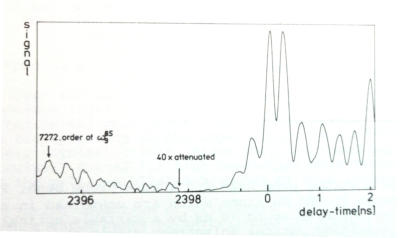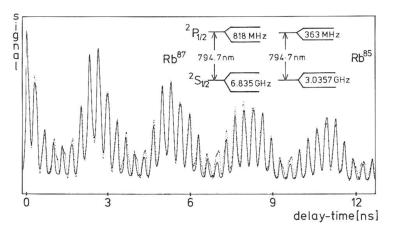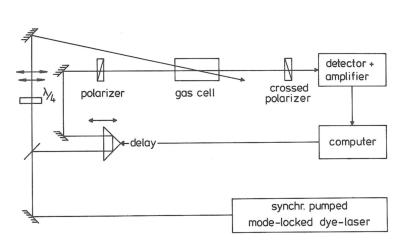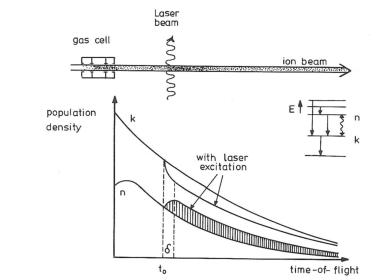H. Lehmitz, H. Harde
Freier Induktionszerfall und Polarisierbarkeits-Beats im Cs
Frühjahrstagung der Deutschen Physikalischen Gesellschaft, Sektion Quantenoptik,
Heidelberg, 17. März 1986, Verhandl. DPG (VI) 21, 729 (1986)





b) Time Resolved Laser Spectroscopy of Optical Transients
Ultrashort excitation of atoms and molecules allows time resolved observation of excited states relaxation and measurement of coherent transients. For observations on a picosecond time scale typical electronic detectors are not fast enough. Therefore, methods of higher time resolution are applied, which take advantage of transforming the time scale t to a length l via the velocity v with t = l/v.Fast Beam Spectroscopy
Ions can be accelerated up to velocities of several % of the speed of light c. When these ions pass a gas cell or a thin carbon foil, they are further ionized or also neutralized and at the same time excited to higher atomic states. Subsequent selective excitation with a conti- nuously operating laser allows a well controlled population change of the involved atomic states. By measuring the fluorescence of the atoms or ions with and without laser excitation as a func- tion of the time of flight (distance after excita- tion) makes possible cascade free lifetime mea- surements of highly excited atomic or ionic states on a picosecond time scale. A sufficiently short excitation can also prepare coherent superpositions of sub-levels in the ex- cited or lower state, when the inverse of the excitation time covers the splitting of adjacent sub- levels. Then coherent transients are observed on the free induction decay. These transients are oscillating with the respective sub-level splitting frequencies and are known as quantum beats. They allow Doppler-free measurements of splitting frequencies.Quantum Beats in Forward Scattering
An excitation and detection scheme using a transformation of time to length by the speed of light c is known as pump-probe experiment. The time evolution of coherently excited states after an excitation by an ultrashort pump pulse can sensitively be detected by a time delayed probe pulse, which passes an optical delay line and crossed optical polarizers. Recording the average transmitted intensity of the probe pul- ses behind the polarizer as a function of the delay then allows to sample the time evolution of the coherently prepared sub-states in for- ward scattering. Since mode-locked lasers are typically generating pulses with repetition rates in the MHz up to the GHz range, integration over millions of pulses for each delay time significantly improves the signal-to-noise ratio. A measurement with 85 Rb (72% abundance) and 87 Rb (28%) demonstrates the high sensiti- vity and time resolution of the set-up for the observation of coherent transients in the time domain, reflecting directly the respective level splittings of the excited and ground states.Quantum Beats at “Negative” Delay Times
The accuracy of measuring frequency splittings in the time domain is generally limited by the finite delay time, and thus the observation time of typically several ten nanoseconds. With a synchronously pumped mode-locked and cavity dumped dye-laser, however, long lived coherent transients as they are expected in the ground state, can also be measured after delay times of several µs, and this with ps time resolution. Taking advantage of the well-known and extremely stable laser pulse separation time an atomic coherence created by a pump pulse, can be sampled by a probe pulse derived from the next pulse of the pulse train. At “negative” delay times then the time evolution of atoms is measured after one pulse period reduced by the respective delay time. This figure shows the beat pattern of the 85 Rb ground state splitting with 3.04 GHz, on the left side for negative delays displaying beats after almost 2.4 µs, on the right side directly after zero delay. From such measurement the beat period can be interpolated over the full time interval, and according to Fourier’s theorem the ground state splitting can be determined within 100 kHz.Observation of 500 GHz Quantum Beats
A coherent superposition of the 3p sodium fine-structure states with a wavelength splitting of 0.6 nm or a frequency difference of 517 GHz requires simultaneous excitation of the D 1 and D 2 resonance lines at 589 nm with subpicosecond pulses. A synchronously pumped mode-locked dye- laser with saturable absorber in the dye gene- rates pulses of 400 femtoseconds duration at a repetition rate of 84 MHz. Together with a pola- rization selective detection scheme well resolv- ed fine-structure quantum beats in forward scattering with an oscillation period of 1.9 ps can be measured, demonstrating the ultrahigh time resolution of this experimental set-up.Doctoral Theses
H. Harde Cascade-Free Lifetime Measurements with Fast Ion Beams after Combined Gas-Laser-Excitation - Development of a Set-Up and First Measurements with Ba+, Na, Ne und Li+ Physics Department, University of Kaiserslautern 1974 H. Burggraf Hochauflösende Spektroskopie mit ultrakurzen Laserpulsen am Natrium School of Electrical Engineering, Helmut-Schmidt-Uiversity, Hamburg 1985 H. Lehmitz Kohärenzspektroskopie mit ultrakurzen Lichtimpulsen – Zeit- und frequenzaufgelöste Messungen am Beispiel von Cäsium sowie Voruntersuchungen zu Messungen an gespeicherten Ytterbiumionen School of Electrical Engineering, Helmut-Schmidt-Uiversity, Hamburg 1989Refereed Publications in Journals and Conference Digests
H. Harde, G. Guthöhrlein New Method for Cascade-Free Lifetime Measurements Physical Review A 10, 1488 (1974) H. Harde Intracavity Dye-Laser Excitation of Fast Ions and Atoms Summaries of the Sixth Conference of the ''European Group of Atomic Spectroscopy'', European Physical Society, Berlin, p. 65 (1974) H. Harde Cascade-Free Lifetime Measurements by Laser Excitation of Foil- or Gas-Excited Beams in ''Beam-Foil Spectroscopy 2'', ed. by J. A. Sellin and D. J. Pegg (Plenum Press, New York 1976), p. 859 (1976) D. Schulze-Hagenest, H. Harde, W. Brand, W. Demtröder Fast-Beam Spectroscopy by Combined Gas-Cell-Laser Excitation for Cascade-Free Lifetime Measurements of Highly Excited States Zeitschrift für Physik A 282, 149 (1977) H. Harde, H. Burggraf, J. Mlynek, W. Lange Time-Resolved Polarization Spectroscopy of Coherent Transients: Picosecond Studies with a Mode-Locked Dye Laser Technical Digest of Topical Meeting of Picosecond Phenomena (Optical Society of America, Washington DC, 1980), post-deadline paper, p. THB16 (1980) H. Harde, H. Burggraf, J. Mlynek, W. Lange Hyperfine Quantum Beats in Transmission: Subnanosecond Studies by Means of a Mode-Locked Dye Laser Europhysics Conference Abstracts of 12th EGAS-Conference 4 E (European Physical Society, Pisa, 1980), p. 71 (1980) H. Harde, H. Burggraf, J. Mlynek, W. Lange Quantum Beats in Forward Scattering: Subnanosecond Studies with a Mode-Locked Dye Laser Optics Letters 6, 290 (1981) H. Harde Time-Resolved Coherence Spectroscopy in Rb Vapor Conference Abstracts of Ninth International Conference on Atomic Physics, ed. by R. S. Van Dyck Jr. and E. N. Fortson (University of Washington, Seattle, 1984), p. B 48 (1984) H. Lehmitz, H. Harde Polarization Selective Detection of Hyperfine Quantum Beats in Cs in ''Methods of Laser Spectroscopy'', ed. by Y. Prior et al., Plenum Press, New York, p. 101 (1986) H. Burggraf, M. Kuckartz, H. Harde Observation of 517 GHz Fine Structure Quantum Beats in Na in ''Methods of Laser Spectroscopy'', ed. by Y. Prior et al., Plenum Press, New York, p. 105 (1986) H.Lehmitz, H. Harde Measurement of First-Order Free-Induction-Decay in Cs in ''Methods of Laser Spectroscopy'', ed. by Y. Prior et al., Plenum Press, New York, p. 109 (1986) H. Burggraf, M. Kuckartz, H. Harde Measurement of 1.9 ps Fine Structure Quantum Beats in Na Technical Digest of International Quantum Electronics Conference (Optical Society of America, Washington, D.C., 1986), p. 200 (1986)Contributions on National Conferences and Meetings
H. Burggraf, H. Harde Zeitaufgelöste Polarisationsspektroskopie mit Pikosekunden Laserimpulsen Frühjahrstagung der Deutschen Physikalischen Gesellschaft, Sektion Quantenoptik, Münster, 12. März 1981, Verhandl. DPG (VI) 16, 418 (1981) H. Lehmitz, H. Hoidis, H. Harde Quantunm Beats in Vorwärtsstreuung am Cs mit ps-Zeitauflösung Frühjahrstagung der Deutschen Physikalischen Gesellschaft, Sektion Quantenoptik, Bayreuth, 27. März 1985, Verhandl. DPG (VI) 20, 1054 (1985) M. Kuckartz, H. Harde Beobachtung von 517 GHz Quantum Beats in Na Frühjahrstagung der Deutschen Physikalischen Gesellschaft, Sektion Quantenoptik, Heidelberg, 17. März 1986, Verhandl. DPG (VI) 21, 728 (1986)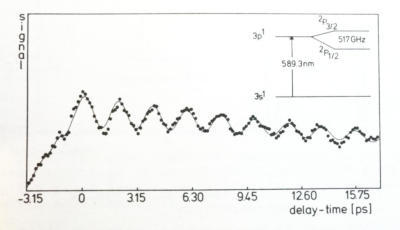

Physics & Climate


